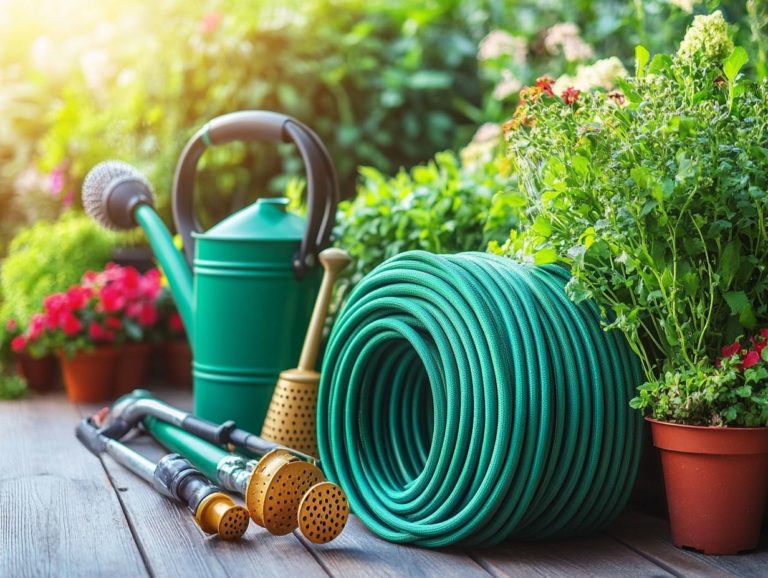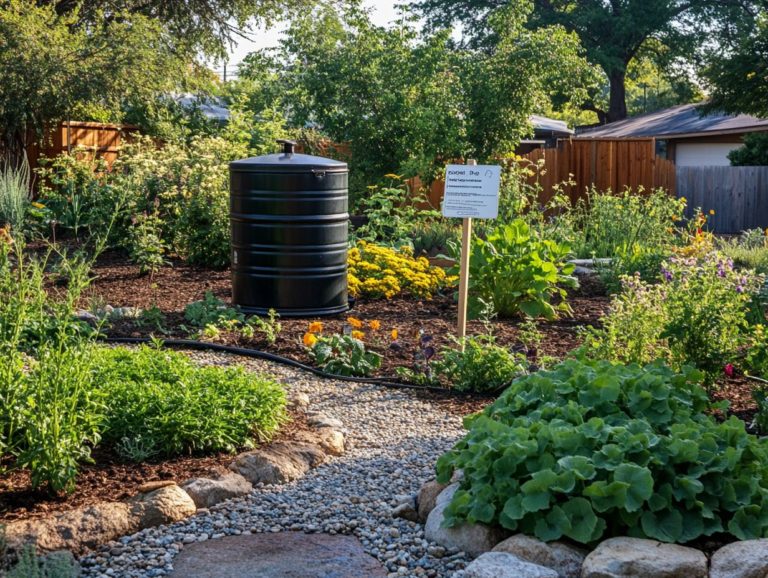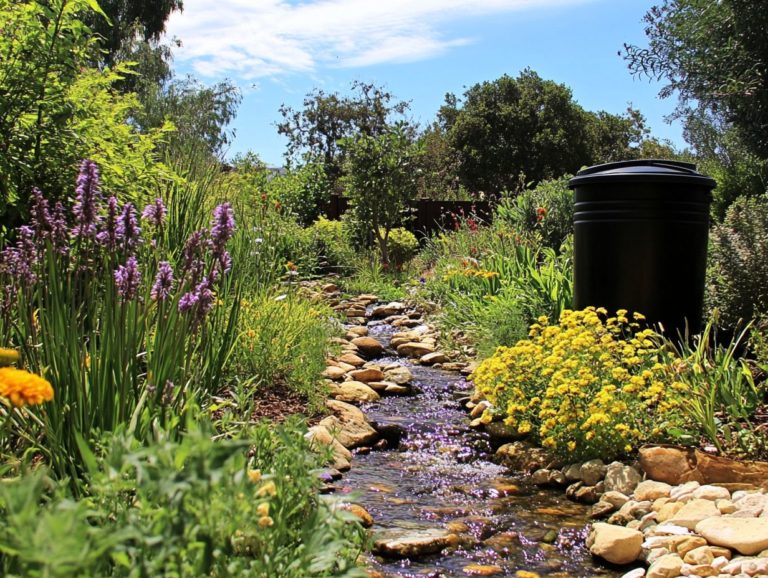Understanding Greywater Recycling in Gardening
Greywater recycling is a smart way for sustainable gardening. It uses water from everyday activities like showering and laundry to nourish your plants.
This guide explains greywater recycling and its key principles. It highlights benefits, especially for gardening.
You ll discover how this practice saves water, cuts costs, and improves soil quality and plant health.
Whether you re a seasoned gardener or just starting out, this guide will empower you with knowledge for eco-friendly choices that enrich your garden.
Contents
- Key Takeaways:
- What is Greywater Recycling?
- Benefits of Greywater Recycling in Gardening
- Types of Greywater Recycling Systems
- How to Set Up a Greywater Recycling System
- Top Tips for Thriving Gardens with Greywater!
- Frequently Asked Questions
- What is greywater recycling in gardening?
- Why should I consider implementing greywater recycling in gardening?
- How do I set up a greywater recycling system for my garden?
- What are some important factors to consider when using greywater for gardening?
- Are there any risks associated with using greywater for gardening?
- Can I use greywater to water my lawn or ornamental plants?
Key Takeaways:

- Greywater recycling uses household water from sinks, showers, and laundry for irrigation.
- This practice saves water and reduces bills while improving soil and plant health.
- Different greywater systems are available, and setting one up is simple and safe with best practices.
What is Greywater Recycling?
Greywater recycling collects and reuses wastewater from activities like washing dishes and bathing. It excludes water contaminated with feces, known as blackwater.
Recycling greywater is essential for effective wastewater management. This eco-friendly approach enhances sustainable gardening and urban farming while conserving water.
When you use greywater systems, you can significantly cut your household water use. This helps lessen the environmental impact of water usage at home.
Definition and Basic Concepts
Greywater comes from relatively clean sources like kitchen sinks and showers. It s ideal for irrigation systems in your garden.
This water differs from blackwater, which contains human waste and is more polluted. With proper treatment, greywater becomes a valuable resource for non-potable uses.
By redirecting greywater for landscape irrigation and toilet flushing, you reduce overall water consumption. This practice conserves fresh water and eases the load on sewage systems.
Benefits of Greywater Recycling in Gardening
Recycling greywater has many benefits. It promotes water conservation and leads to cost savings.
It also improves plant health key for sustainable gardening and urban agriculture. This approach aligns with a commitment to environmental stewardship.
Water Conservation and Cost Savings
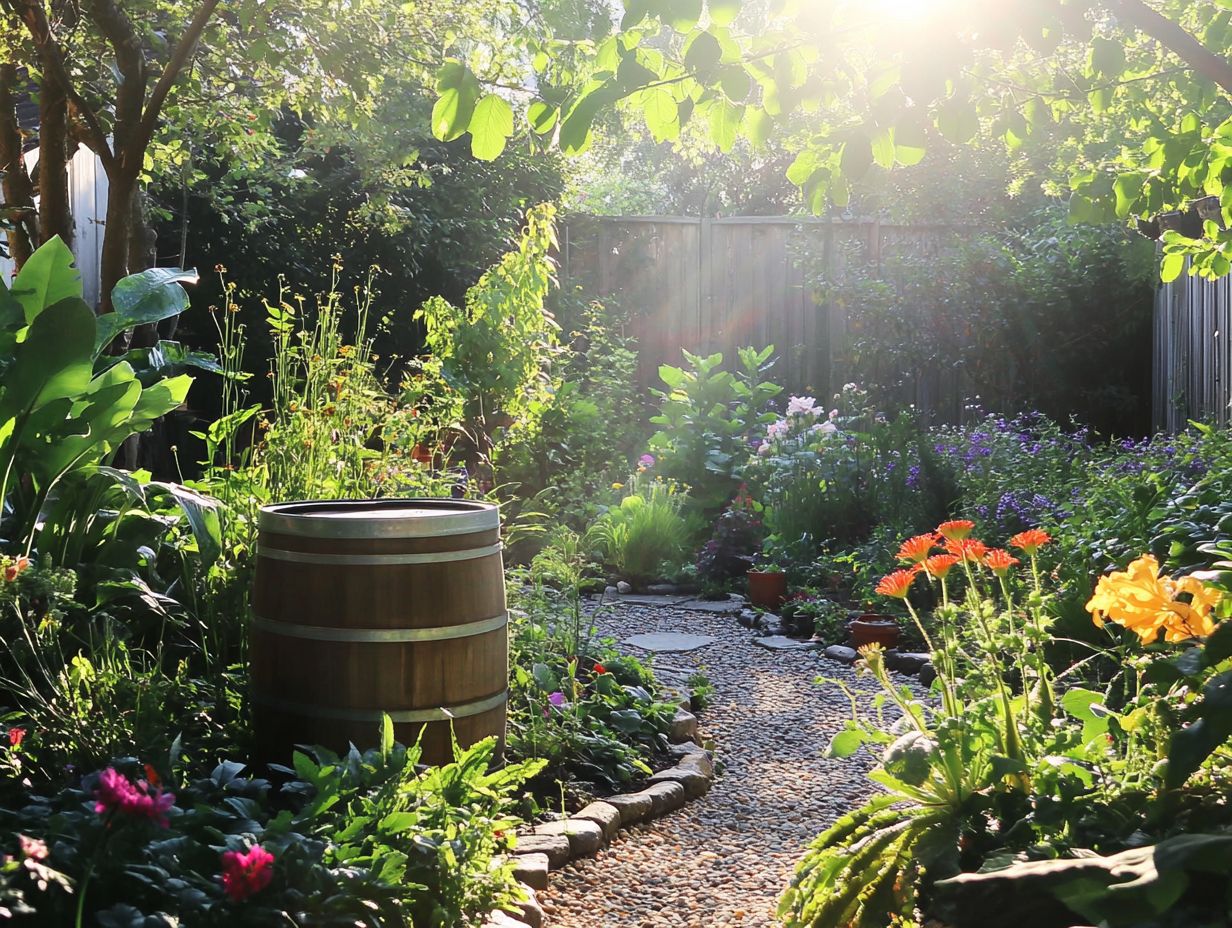
One of the most compelling advantages of greywater recycling is its ability to conserve significant amounts of water, leading to impressive cost savings for you and your household by lessening reliance on treated water from municipal systems. This is particularly relevant during water restrictions.
By implementing greywater collection systems, you can effortlessly reuse water generated from sinks, showers, and washing machines for irrigation and toilet flushing, paving the way for a more sustainable lifestyle. This practice can significantly ease the strain on local resources during peak demand. It becomes vital during water restrictions that many urban areas face.
As communities work to build resilience against climate change, adopting water management strategies like greywater recycling lowers your water bills while playing a part in broader environmental initiatives.
Ultimately, embracing such innovations creates a conservation mindset that benefits everyone, particularly in densely populated regions where water resources are often stretched to their limits.
Improving Soil Quality and Plant Growth
Using greywater in your gardening routine not only conserves precious water but also enriches soil quality by introducing organic matter, enhancing plant growth and fostering healthier ecosystems.
This method effectively recycles used water from everyday household activities, such as washing dishes and doing laundry, returning essential nutrients to the soil. Many gardeners have witnessed remarkable results with vegetable plants like tomatoes and zucchinis, which flourish when nourished with greywater, benefiting from the extra potassium and nitrogen.
Ornamental plants, like marigolds and daylilies, can also experience enhanced growth, showcasing vibrant blooms as they absorb this nutrient-rich fluid.
By employing greywater responsibly, you can optimize your plants’ potential while supporting sustainable practices that enrich the surrounding environment and contribute to water efficiency.
Types of Greywater Recycling Systems
You ll find a variety of greywater recycling systems designed to cater to your unique household needs. Each system adheres to greywater regulations and efficiently manages your irrigation requirements, ensuring that you make the most of your resources while contributing to sustainability.
Overview of Different Systems
An overview of different greywater systems showcases a variety of methods for recycling greywater, designed for both indoor gardening and outdoor watering, while efficiently managing your irrigation needs.
These systems incorporate an array of components, including filters, storage tanks, and pipes, all aimed at facilitating the safe and efficient reuse of water from sinks, showers, and laundry.
Understanding how these various greywater setups function is essential, as they can be tailored for different gardening applications, whether you prefer drip irrigation (a method that delivers water directly to the plant roots) or surface watering, emphasizing water filtration processes.
For example, some systems are perfectly suited for arid environments where water conservation is paramount, while others thrive in more temperate climates where rainfall is abundant.
By effectively recycling greywater, you support sustainable gardening practices and bolster the resilience of your landscapes against the challenges of water scarcity.
How to Set Up a Greywater Recycling System
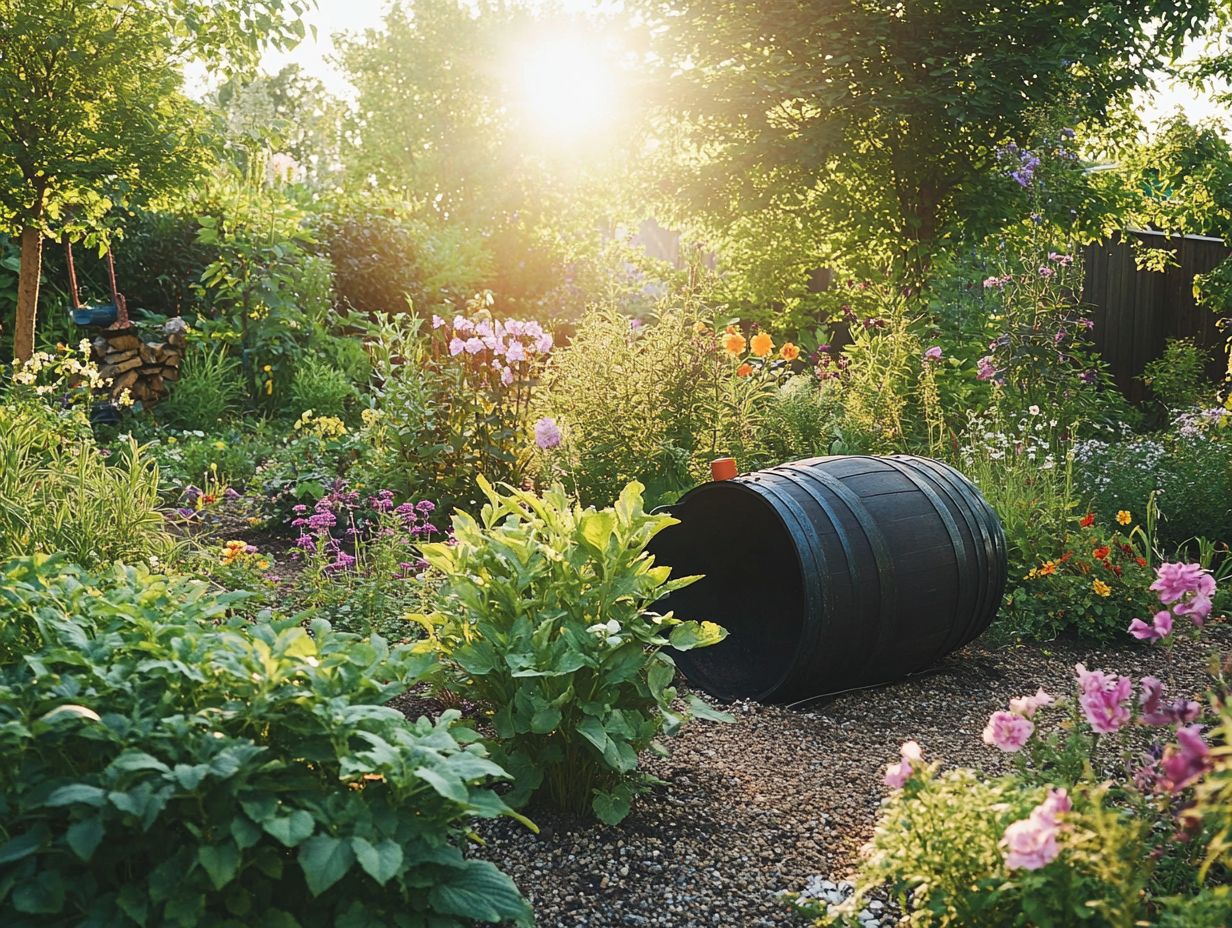
Establishing a greywater recycling system in your home requires a thoughtful approach, encompassing quality assessments, meticulous planning, and essential plumbing modifications. This ensures adherence to greywater guidelines and promotes the safe reuse of water.
Start your greywater recycling journey today to save water and money!
Step-by-Step Guide
This step-by-step guide presents the essential procedures you need to effectively install a greywater system, from the initial assessment all the way to the final installation in your home, promoting wastewater management the process of handling used water from your home.
- Start with a thorough evaluation of your plumbing layout to identify potential sources for greywater collection, such as sinks, showers, and washing machines.
- Understanding local regulations is your next essential task; these may dictate specific plumbing modifications and system requirements that you must follow.
- Once you complete the planning phase, selecting the right greywater treatment system becomes crucial it should be tailored to your household’s water output and garden needs.
- After that, prepare for installation by gathering the necessary tools and materials, ensuring that all components, including pipes, filters, and storage tanks, comply with safety standards.
By following this comprehensive approach, you will not only ensure efficient water reuse but also promote sustainable practices within your household.
Top Tips for Thriving Gardens with Greywater!
Implementing best practices for utilizing greywater in your gardening endeavors is essential for optimizing its benefits while mitigating potential risks. By ensuring you use plant-friendly products and water-compatible soaps, you can create a thriving garden that truly flourishes.
What to Avoid and How to Maximize Benefits
To get the most out of your greywater, avoid these common mistakes! Avoid harsh chemicals and instead focus on using water-friendly soaps and plant-friendly products.
Neglecting this crucial aspect of wastewater management can have serious repercussions for both soil health and plant vitality. Certain household cleaning agents, for instance, can introduce salts or toxic substances that disrupt the delicate balance of beneficial microorganisms in your soil. This disruption can hinder nutrient absorption, leading to stunted growth or, in the worst-case scenario, plant death.
To navigate these common pitfalls in sustainable gardening, it s wise to choose natural, biodegradable products products that break down naturally and are safe for the environment specifically designed for greywater reuse. Seek out water-friendly soaps made from vegetable oils and those labeled as phosphate-free to ensure they re safe for your gardening needs.
Using mulch can absorb excess salts effectively, enhancing water retention and fostering a healthier growing environment.
Don t miss out watch this informative video now to master greywater guidelines and water-saving techniques to enhance your gardening.
Frequently Asked Questions

What is greywater recycling in gardening?
Greywater recycling in gardening is the process of reusing household water, such as from kitchen sinks, showers, and washing machines, to irrigate and nourish plants in your garden.
Why should I consider implementing greywater recycling in gardening?
Greywater recycling in gardening not only conserves water but also supports water reuse strategies, reduces your water bill, and benefits your garden by providing a nutrient-rich water source.
How do I set up a greywater recycling system for my garden?
The first step is to determine which household greywater sources you want to collect from, including kitchen sinks and showers. Next, you will need to install a diversion system to redirect the water from these sources to your garden. Finally, you will need to filter the greywater using wastewater management techniques and distribute it evenly throughout your garden.
What are some important factors to consider when using greywater for gardening?
It is important to use biodegradable and eco-friendly soaps and detergents to minimize the impact on your plants and soil. You should also avoid using greywater on vegetable plants and always wear gloves when handling greywater.
Ready to transform your gardening with greywater? Start today!
Are there any risks associated with using greywater for gardening?
Yes, there is a potential risk of contamination if greywater isn t filtered and distributed properly. Regularly maintain and monitor your system that reuses water from sinks, showers, and washing machines to ensure it works well, especially during dry spells.
Can I use greywater to water my lawn or ornamental plants?
You can definitely use greywater on non-edible plants in your garden! For edible plants, it’s best to have a separate system to reduce any health risks.




